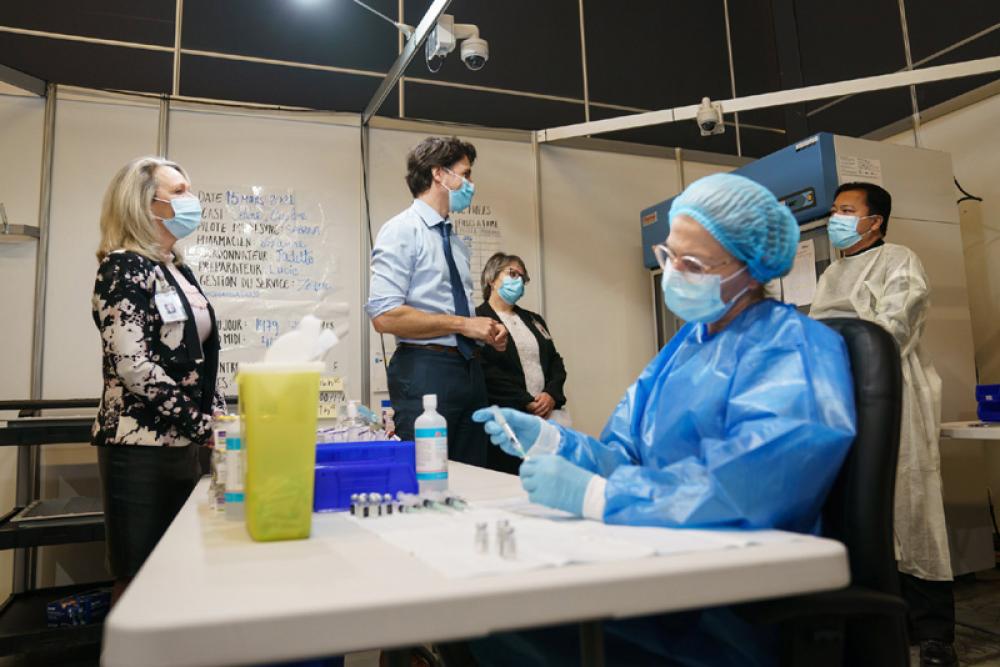Meghan Pereira | @justearthnews | 18 Mar 2021, 09:49 am Print
 Canada Vaccination
Canada Vaccination Image credit: Justin Trudeau Facebook
Toronto: Last week, Health Canada cleared the fourth Covid-19 vaccine as a part of a national campaign to vaccinate the population. The Johnson & Johnson vaccine joins the Pfizer-Biontech vaccine, with a 95% efficacy rate, alongside the Moderna and AstraZeneca-Oxford vaccines.
According to data from the University of Toronto, over 3.03 million doses have been administered to the Canadian public; the highest concentration in Ontario with over 250,000 inoculations in the last seven days.
The Pfizer, Astra-Zeneca, and Moderna vaccines have arrived in Canada, though the Johnson & Johnson vaccines may only be available to the public once they land in late spring.
The Astra-Zeneca COVISHIELD vaccine created in collaboration with Oxford University and manufactured by the Serum Institute of India will be delivered this month.
While these four have been approved, Health Canada is pending approval for three additional manufacturers. If all seven of these vaccines are approved, the Canadian population can expect to receive over 400 million doses- far more than required for the 38 million people who live in Canada.
Trudeau remarked that he is open to sharing leftover vaccines with the world “if we have more vaccines than necessary,” which looks to be the case if delivery remains on schedule.
While it is up to the provincial government to administer vaccines, the federal government does play a role in how these immunizations are procured. In February, it was announced that Novavax would begin manufacturing doses domestically in Montreal: though doses would be unable to be administered until this fall at the latest.
Canada does not have the facilities nor the expediency to be able to manufacture doses domestically, and so it is the federal government’s responsibility to the Canadian population to secure vaccinations from abroad.
The lack of efficiency in this endeavour exposes the tough position in which this nation lies. Canada’s most trusted neighbour and closest trade partner, the United States of America, continues to bear witness to what can only be described as a nightmare situation in both the pandemic’s handling and its aftermath.
.jpg)
Under the Trump Administration, Trudeau was hesitant to procure inoculations from the United States and instead turned to Europe for its doses, afraid of Trump’s potential export bans on the vaccines. What he did not expect was to be turned away and sent to the back of the line, to have to wait for months like everyone else who had waited longer than they should have, only to potentially face such bans from the European Union.
President Biden maintains his “America-first” position, stating that he will only decide on exporting vaccines to Canada from the Pfizer plant in Michigan and the Moderna plant in New Hampshire after every adult American has been vaccinated; what many have been calling “vaccine nationalism.”
Health Canada had its fair share of warnings, stemming back to the SARS outbreak.The main source of Canada’s frustrations catalysed from delayed delivery from Pfizer’s Belgium facility, as well as murky short term delivery blockages from Moderna likely from growing global demand.
A 2003 report offered advice for “longer term action regarding infectious disease control and prevention,” with one of its main recommendations focused on re-introducing a “national vaccine strategy” first proposed in late 1993 after the spread of HIV. Fourteen years after the report, this pandemic had shed light on the inability to heed prior warnings.
Canada’s peaceful diplomacy and relative progressiveness has positioned this state to be the world’s calm, friendly neighbour. As the pandemic loomed in March 2020, Canada was placed on a pedestal for overall better social distancing, mask compliance, and lockdown commitments than their southern counterparts. Relative to the United States, Canada has seen less than half the deaths per capita- yet the Canadian population will only see its entire adult population vaccinated by September, while President Biden aims to cover every single adult in the United States by May.
Many Canadians are justifiably frustrated about the lack of clarity in deriving some form of provincial list or hierarchy. Long term care residents did not receive the initial shipments of Pfizer vaccines in the volume that they should have, as the majority of doses went to front line healthcare workers as a part of Stage 1 of the vaccine rollout.
Stage 2, which is expected to launch in the second quarter, aims to immunize essential workers––including teachers and first responders––those who live in shared living communities, and adults in marginalized and urban communities. Stage 3 will focus on adults 50 years or older, adults with underlying medical conditions, and non-frontline essential workers.
A nation that was once exemplary in its handling of the pandemic is now down to its knees for a vaccine plan. As we begin to see warmer spring days, let this be a chance for optimism: that the True North is indeed strong and free, and will somehow recover together.
- Are birth control pills affecting your mental health? New study raises red flags
- WHO declares obesity a chronic disease: Why experts are now recommending wider use of weight-loss drugs
- Global measles crisis: 30 million children miss vaccines as cases skyrocket!
- 1 in 6 affected! WHO reports an alarming rise in infertility across the globe
- A daily cup of cocoa or tea can protect your heart from the hidden damage of long sitting hours: Study



-1763561110.jpg)


